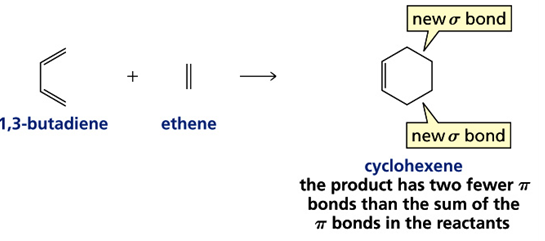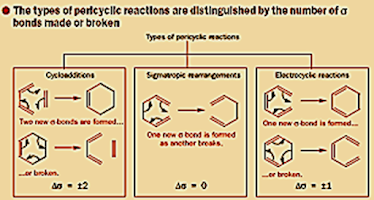Photochemistry, Free radicals and Pericyclic reactions
Multiple Choice questions
1. Stilbene on photochemical reaction gives cis stilbene and trans stilbene what will be the percentagea) 50:50b) 93:7c) 67:33d) 60:40Ans. (b)
2. Rearrangement of 1,4-Diene by photochemical process this rearrangement is called as
a) di-pi methane rearrangement
b) Zimmerman rearrangement
c) Both a and b
d) None of these
Ans. (c)
3. Irradiation of benzene gives
a) Benzvalene
b) Fulvene
c) Dewar benzene
d) All of the above
Ans. (d)
4. Ortho xylene on irradiation with photon of light gives
a) Only meta xylene
b) Only para xylene
c) Mixture of o,m,p-xylene
d) None of these
Ans. (c)
5. Ketene formation takes place in
a) Norrish Type-1
b) Norrish Type-2
c) Both a and b
d) None of these
Ans. (a)
6. β bond cleavage observed in which of the Photochemical process
a) Norrish Type-1
b) Norrish Type-2
c) Both a and b
d) None of these
Ans. (b)
7. α- bond cleavage observed in which of the Photochemical process
a) Norrish Type-1
b) Norrish Type-2
c) Both a and b
d) None of these
Ans. (a)
8. Carbonyl group reacts with alkene in photochemical way gives
a) Thioetane
b) Oxetane
c) Oxepane
d) All of these
Ans. (b)
9. In Paterno Buchi reaction which species is formed?
a) Thioetane
b) Oxetane
c) Oxepane
d) All of these
Ans. (b)
10. Norbornene on Photochemical reaction in solvent Acetone gives
a) Oxetane type product
b) Dimer product
c) Both a and b
d) None of the above
Ans. (b)
11. Photo fries rearrangement is
a) Intermolecular reaction
b) Intramolecular reaction
c) Both inter and intermolecular rearrangement
d) None of these
Ans. (b)
12. In Diels Alder reaction bonds are formed
a) 2 sigma bond 1 pi bond
b) 1 sigma bond 1 pi bond
c) 1 sigma bond 2 pi bond
d) 2 sigma bond 2 pi bond
Ans. (a)
13. Name the reaction between 1,4 Butadiene and quinine in presence of heat
a) Electrocyclic reaction
b) Sigmatropic reaction
c) Cycloaddition reaction
d) All of these
Ans. (c)
14. Trans diene undergoes cycloaddition reaction
a) True
b) False
c) Sometime correct
d) Depend on temperature
Ans. (b)
15. When both Diene and dienophiles are cyclic then which adduct formed abundantly
a) Endo adduct
b) Exo adduct
c) Internal adduct
d) External adduct
Ans. (a)
16. Which of the following group acts as withdrawing group in Diels Alder Reaction?
a) CHO
b) COOH
c) Both a and b
d) CH3
Ans. (c)
17. Cycloaddition reactions are
a) Supra facial
b) Antra facial
c) Superfacial
d) Downfacial
Ans. (a)
18. First sigmatropic reaction discovered as
a) Schemidt rearrangement
b) Cope rearrangement
c) Claisen rearrangement
d) None of these
Ans. (c)
19. Thermal electrocyclic reactions involving (4n + 2) pi electrons are
a) Disrotatory
b) Conrotatory
c) Antrafacial
d) Suprafacial
Ans. (a)
20. Thermal electrocyclic reactions involving (4n) pi electrons are
a) Disrotatory
b) Conrotatory
c) Antrafacial
d) Suprafacial
Ans. (b)
21. For Mc-Murry reaction the correct reaction condition is
a) MnCl3/THF 3oK
b) TiCl3/THF 3oK
c) CrCl3/THF 5oK
d) None of these
Ans. (b)
22. Benzene undergoes Birch reduction to give product
a) 1,3-cyclohexadienes
b) 1,5-cyclohexadienes
c) 1,2-cyclohexadienes
d) 1,4-cyclohexadienes
Ans. (d)
23. Benzoic acid undergoes Birch reduction to give…….
a) 2,6-cyclohexadienecarboxylic acid
b) 2,3-cyclohexadienecarboxylic acid
c) 2,5-cyclohexadienecarboxylic acid
d) 2,4-cyclohexadienecarboxylic acid
Ans. (c)
24. Given reduction is called
a) Birch reduction
b) Bouveault-Blanc reduction
c) McMurry Reduction
d) None of these
Ans. (b)
25. Name of given reaction is
a) Birch reaction
b) Bouveault-Blanc reaction
c) McMurry Reaction
d) None of these
Ans. (c)
26. Given reduction is called
a) Birch reduction
b) Bouveault-Blanc reduction
c) McMurry Reduction
d) None of these
Ans. (a)
27. Given reaction is called
a) Sandmeyer Reaction
b) Birch reaction
c) Bouveault-Blanc reaction
d) McMurry Reaction
Ans. (a)













